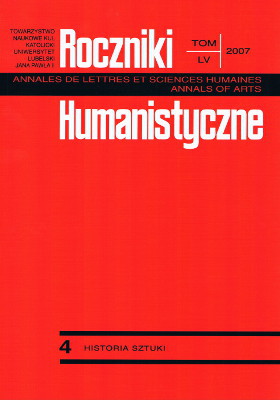Historia przyjaźni Mariana Wawrzenieckiego i Antoniego Gawińskiego
Abstrakt
There are many friendships between artists in the history of art. As new materials appear, we may trace successive interesting relations between artists. One example was the friendship between Antoni Gawiński and Marian Wawrzeniecki. The second artist was thirteen years older than the first one, and his influence was decisively much more important on the younger friend. They met most certainly around 1900, and their friendship survived over forty years, until the times of the Second World War and the year of Marian Wawrzeniecki's death in 1943. When Wawrzeniecki met Gawiński he was already a well-known, though underestimated, artist. He was first of all a respected scientist and archaeologist. The artist-erudite exerted agreat influence on the younger painter who sought his artistic way. They were cemented by their love to art, love to the future, the cult of Jan Matejko, and common artistic views. They both tried to find national elements in the local living colour of Slavonic past and in the unique and individual work of home artists. They criticised S. Witkiewicz and attacked his lack of respect for the historical painting of Jan Matejko and Henryk Siemiradzki. They opposed the hegemony of the Polish Society of Artists “Art”. They attacked in the press their dominance and took part in competitive exhibitions organised by the artists from the groups “Zero” or “Odłam”. Gawiński was most impressed by Wawrzeniecki's illustrations, a fact that was particularly visible in Adolf Dygasiński's Gody życia illustrated in 1910 by he younger artist.
Bibliografia
Albertus, Listy warszawskie, „Kraj” 1904, nr 20, s. 8.
Austen A., Wystawa dzieł Antoniego Gawińskiego i Marjana Wawrzenieckiego, „Sfinks” 1911, z. 48, s. 469-475.
Br. A. [Adam Breza], Wawrzeniecki i Gawiński, „Świat” 1911, nr 47, s.4-5.
Choromański, Wrażenia z wystawy, „Prawda” 1911, nr 46, s. 9-10.
Gawiński A., Notatki o sztuce, „Wędrowiec” 1902, nr 42, s. 832.
Gawiński A., Böcklin, „Wędrowiec” 1903, nr 31, s. 605-606.
Gawiński A., Zwroty, „Wędrowiec” 1904, nr 48, s. 430.
Gawiński A., O Maryanie Wawrzenieckim, „Wędrowiec” 1905, nr 44-46, s.836-837.
Gawiński A., Malarz cierpienia, „Tygodnik Ilustrowany” 1907, nr 47, s. 949-951.
Gawiński A., Marjan Wawrzeniecki. Studjum, „Sfinks” 1910, z. 34, s. 2-19.
h., Mieszaniny literackie. Wydawnictwa gwiazdkowe. Gody życia, „Tygodnik Ilustrowany” 1910, nr 51, s. 1042.
Jabłczyński F., Z powodu artykułów o nacyonalizmie w sztuce, „Ateneum” 1903, z. 7, s. 71-74.
Jaroszyński T., Wystawa wiosenna, „Kurier Warszawski” 1904, nr 133, s.2-3.
Marek A., Sztuka w Łodzi. Otwarcie Stałej Wystawy Sztuk Pięknych, „Świat” 1910, nr 51, s. 5-7.
O., Muzeum huculskie w Kołomyi, „Tygodnik Ilustrowany” 1903, nr 29, s. 274-275.
P. H. [Henryk Piątkowski], Zbiorowa wystawa M. Wawrzenieckiego i A. Gawińskiego, „Tygodnik Ilustrowany” 1911, nr 46, s. 913-914.
Piątkowski H., Wystawa Wawrzenieckiego i Gawińskiego, „Kurier Warszawski” 1911, nr 334, s. 6-7.
Popowski S., Wystawa „Odłamu”, „Sfinks” 1908, nr 4, s. 330-340.
Wankie W., Pierwsza wystawa Tow. „Odłam”, „Świat” 1908, nr 17, s. 10-11.
Wawrzeniecki M., Kilka pytań i uwag w kwestyi narodowej sztuki, „Przegląd Tygodniowy” 1902, nr 23, s. 294.
Wawrzeniecki M., Nowator, „Nowa Gazeta” 1906, nr 176, s. 2-3.
Wystawa wiosenna, „Tygodnik Ilustrowany” 1904, nr 22, s. 426.
Copyright (c) 2007 Roczniki Humanistyczne

Utwór dostępny jest na licencji Creative Commons Uznanie autorstwa – Użycie niekomercyjne – Bez utworów zależnych 4.0 Międzynarodowe.





